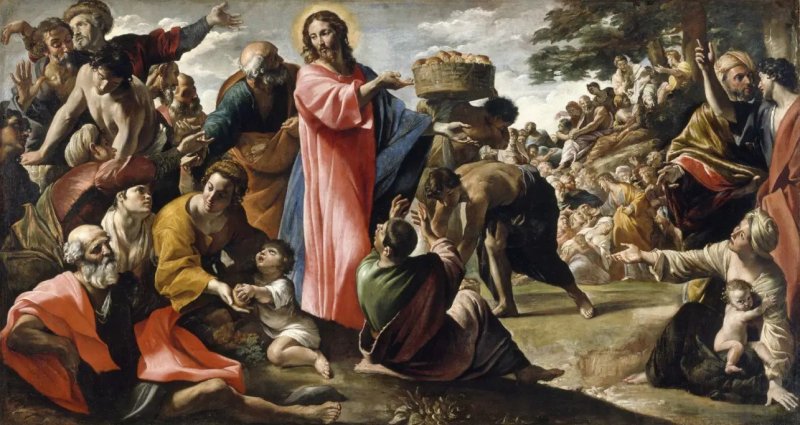
By Joel Padgett, Director of the Office of Catechesis
On Sunday, Sept. 15, the Catholic Church in the United States celebrates “Catechetical Sunday.” Every year, the United States Conference of Catholic Bishops (USCCB) has a theme for the day, and this year’s theme comes from the Gospel of Matthew: “Lord, when did we see you hungry” (25:37). It’s a verse from the “Judgment of the Nations” passage (vv. 31-46) at the end of chapter 25. In this passage, Christ — the shepherd — separates the sheep from the goats. The sheep are those who fed Christ when he was hungry and the goats are those who did not. Both the sheep and the goats asked the shepherd, “When was it that we fed (or did not feed) you?” (cf. Matthew 25:37, 44) and Christ responded, “What you did (or did not do) for one of these least ones, you did (or did not do) for me” (cf. Matthew 25:40, 45).
Feeding the hungry is one of the seven corporal works of mercy. (In fact, six of the seven corporal works of mercy are listed in the aforementioned “Judgment of the Nations” passage. The remaining one, “burying the dead,” has its origin in Tobit 1:17-19.) In addition to its primarily physical aspect, “feeding the hungry” also has a very important spiritual component, as we see, for example, in the fourth Beatitude: “Blessed are they who hunger and thirst for righteousness, for they will be satisfied” (Matthew 5:6). In this latter sense, feeding the hungry is intimately linked with the spiritual works of mercy, which also have their roots in Scripture. Both aspects — feeding the physically hungry and feeding the spiritually hungry — are important. God created us as a unity of body and soul, and both our bodies and our souls need to be fed. We should be careful not to buy into, or to create, any false opposition between the two. They are both dire needs in today’s world and the Church, through us, its members, is called to help satisfy both needs in a way that is consistent with Christ’s Gospel.
According to the USCCB, the overall purpose of Catechetical Sunday is not only to acknowledge the importance of the wonderful ministry that our catechists provide through teaching the faith to others, but it is also, “a wonderful opportunity to reflect on the role that each person plays, by virtue of baptism, in handing on the faith and being a witness to the Gospel.” As such, “Catechetical Sunday is an opportunity for all to rededicate themselves to this mission as a community of faith,” and our mission as witnesses of Christ is lived out in both a corporal and a spiritual way.
Moreover, the USCCB points out that this year’s theme — “Lord, when did we see you hungry” — is meant to reflect our call to missionary discipleship. It is meant to remind us that “every member of the faithful is called to holiness and to mission.” Consequently, “we are called to be Eucharist by word and action to our brothers and sisters in Christ. Our times cry out for this kind of holiness, one inflamed by the ardent determination to bring as many of our brothers and sisters as possible to Christ.” (On a side note, I don’t think it’s by chance that the Eucharist is both spiritual and physical food.)
In bringing our brothers and sisters to Christ, let us indeed seek to feed their hunger, both physical and spiritual. There are definitely those who are “most in need,” and we need to never forget or abandon them. At the same time, there are also those whom Christ places along our path every single day. Maybe some are in great need, and maybe the needs of others aren’t quite as apparent. However, everyone — ourselves included — needs to be fed on a regular basis, and authentic nourishment, both physical and spiritual, isn’t always a given.
Our great example and model is Christ. At times, he sought out and healed those in physical need, but even among these, he often brought to their attention the importance of their spiritual health. At other times, he gave great spiritual discourses, but never to the point of neglecting the physically sick and infirm in the crowd. Take, for example, the many meals that he shared with others. I highly doubt that either Simon the Pharisee (Luke 7:36-50) or Zacchaeus, before his conversion, (Luke 19:1-10) were in much need of physical sustenance. However, Jesus did not let either occasion go by without addressing the state of their soul. On the other hand, when the crowds followed Jesus to a deserted place and had been listening to him speak of the kingdom of God, He also healed those in need and multiplied loaves and fish in order to satisfy their stomachs (cf. Luke 10-17).
Personally, I like to meditate on the simple, everyday meals that Christ would have shared with just the Twelve Apostles. While their bellies were being filled, I cannot imagine that Christ was not also nourishing their hearts and souls. There are a couple of parables that Jesus explained in private to his disciples, such as the parable of the sower (Mark 4:10-20) and the parable of the weeds (Matthew 13:36-43). Although Scripture doesn’t indicate exactly when or where Jesus explained these to his disciples, I like to imagine him doing so while eating a meal with them at the end of a long day of preaching, teaching and healing. Perhaps our “mission field” doesn’t resemble the rugged terrain of the Holy Land, or perhaps in some ways it does. … Regardless, it does resemble our “dinner table,” wherever it may be and with whomever it is shared.
